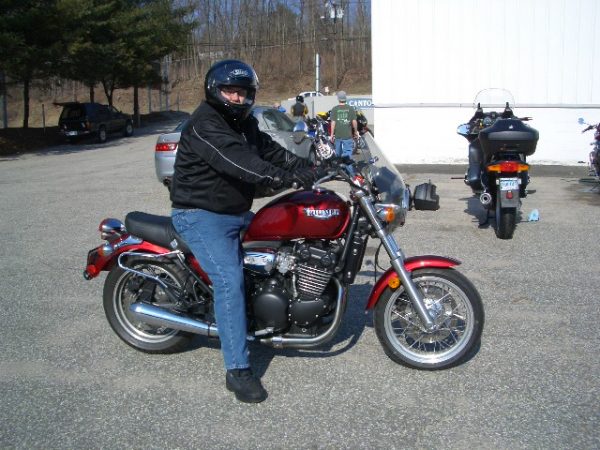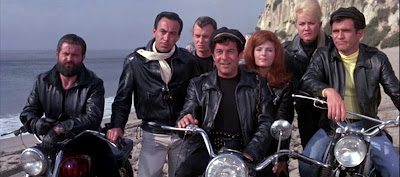***CLASSIC RIDE-CT***
(Editor’s note: Because they’ve never appeared on online, RIDE-CT.com today begins reprinting in edited form some early RIDE-CT columns that appeared in “The Republican-American” newspaper.)
By Bud Wilkinson of RIDE-CT.com
The outlaw image of motorcyclists, personified by Marlon Brando in the 1953 biker movie “The Wild One,” got an extreme makeover in the ’60s thanks to an ingenious advertising campaign that proclaimed “You meet the nicest people on a Honda.” Motorcycles were no  longer solely the domain of leather-clad outlaws. They were now wholesome fun for everyone.
longer solely the domain of leather-clad outlaws. They were now wholesome fun for everyone.
Motorcycle gangs were soon even mocked in a half-dozen beach movies in the 1960s that featured Harvey Lembeck’s over-the-handlebars portrayal of Eric Von Zipper, the inept biker leader of a gang known as the RATZ and Mice.
The changing image of motorcycles, further boosted in the early ’70s by Kawasaki’s equally memorable slogan “Let the Good Times Roll,” had teenage boys salivating to do just that. With few exceptions, their panic-stricken moms responded, “You’re not getting a motorcycle. You’ll kill yourself.” My mother died in 1984 but her warning echoed persistently over the decades. However, in October 2004, at age 51, I ignored her admonition and impulsively purchased a used motorcycle.
The two-wheel itch had firmly taken hold a few weeks earlier when I stopped at (the now long-gone) Canton Cycles in Winsted where friend Carl Foster was picking up his BMW from service. On the showroom floor was a used ’99 Triumph – an 885cc Legend with low miles and sparkling burgundy paint job.
Wasn’t Triumph the British brand that James Dean preferred?
Didn’t Steve McQueen ride a Triumph in the movie “The Great Escape?”
Hadn’t Fonzie cruised to Arnold’s Drive-In on a Triumph on the TV sitcom “Happy Days?”
Actually, those questions didn’t enter my mind until much, much later. Nonetheless, suddenly, I was like Ralphie, the character in the movie “A Christmas Story” who wanted a BB gun. Yes, my mother had also invoked the warning “You’ll shoot your eye out,” but she relented and allowed me to have a Winchester Model 1894 air rifle as a kid. That was then, this was now, and my reaction was, “Give me the bike.”
 Being a mature adult, I mulled the purchase for a few days before inevitably making a down payment. The dealership promised to add new tires and replace a finicky tachometer. A short time later, and just six days shy of the 20th anniversary of my mother’s death, Carl rode the Legend home to my garage – where it sat, its three-cylinder engine silent because its new owner knew nothing about riding.
Being a mature adult, I mulled the purchase for a few days before inevitably making a down payment. The dealership promised to add new tires and replace a finicky tachometer. A short time later, and just six days shy of the 20th anniversary of my mother’s death, Carl rode the Legend home to my garage – where it sat, its three-cylinder engine silent because its new owner knew nothing about riding.
Mom didn’t raise a total fool and common sense dictated that a “newbie” should enroll in a state Department of Transportation-certified rider training course to learn the rules of the road, safe operation and proper techniques.
At the time, there were 10 spots in Connecticut where aspiring riders could enroll in the Basic Rider Course. It was the end of the season and most sites had wrapped up their courses for the year. Through relentless searching I found an open slot across the state in Plainfield. I immediately enlisted in motorcycle boot camp and, just two days after getting the Triumph home, began the 75-mile commute each way for three consecutive days of classroom instruction and intense hands-on practice.
The riding portion of the course, with bikes provided for students, would take place come rain or come shine. That also included cold. It was 40 degrees when the class walked outside that Saturday morning for our first on-bike experience, having spent the previous evening hunkered down in a classroom.
The dozen or so students in the class, male and female, ranged in age from their 20s to their 50s. We’d all been warned that at any point an instructor could pull you aside, tell you that you’re not cut out for riding and send you home. Being rebels with a cause, we pushed those thoughts aside as we first learned the start-up routine and how to “duck walk” the bikes.
Not only is riding a motorcycle dangerous, it’s complicated for a beginner. That reality became apparent when the instructors, using a strange vocabulary, began piling on information — from the easy operation of the “petcock” (the valve that controls gas flow from the tank to the engine) to getting a feel for the “friction zone” (the point where the clutch engages) and the proper technique for “counter steering” (which enables you to lean your bike over when going around curves).
I immediately realized that someone 50+ doesn’t process information and acquire new skills as quickly as a teenager. While the initial reaction was panic from sensory overload, I forcefully relaxed and practiced. As the instructors patiently gave advice, layering on drills, the class slowly learned how to take off smoothly in first gear and upshift, to stop quickly, to accelerate on a curve and to swerve for imaginary objects in the road. Only one classmate lost control and dumped his bike on the tarmac.
Saturday’s daylong session ended with my mind fatigued and my limbs and butt sore. Sunday morning it was more of the same, with my outlook seesawing between “you can do it” and downbeat concern over the upcoming final exam. After lunch, the class reconvened to find out just much we’d learned.
The final exam required each rider to do back-to-back U-turns (essentially a figure-8) inside a box painted on the asphalt, swerve at medium speed, and rapidly accelerate through a curve and end with a quick stop. There may have been more, but after failing the U-turn drill by riding outside of the lines and putting my foot down, I was sure that I’d flunked the final. The perfect 100 that I’d gotten earlier on the written test didn’t matter. With the pressure to pass now gone, I dutifully and disconsolately completed the remainder of the exam to the best of my ability.
Maybe I wasn’t meant to ride a motorcycle. Maybe my mother was right those many years ago. Maybe I’d impetuously wasted several thousand dollars on that piece of “British iron” sitting in my garage. The exam over, we reassembled in the classroom where the lead instructor deadpanned, “I have some good news and some bad news.”
“Here it comes,” I thought. “Not everyone passed. Maybe only one person failed. Me.”
“The good is,” the instructor continued, “is that everyone passed.”
“The bad news is that everyone passed,” he added, cautioning us that the real work in learning to ride properly and safely would begin in earnest once we actually got out on the streets, and that everyone should continue to practice the drills we’d learned.
Afterwards, concerned over my inability to master slow-speed U-turns, I asked the instructors, “Should I bother riding?” They replied affirmatively, reiterating that skill only comes with practice.
Arriving home exhausted as dusk settled and more relieved than pleased, even though my diploma now exempted me from taking the required on-cycle licensing skill test at D.M.V., I entered the garage where my motorcycle was gathering dust. I climbed on the seat and looked down at the seemingly hulking Triumph.
It was huge – a cruise liner compared to the dinky 250cc sculls that we had ridden in class. There was no way I would ever dare to take this 516-pound monster out of the driveway.
—
For those who remember back to the ’60s, here are a couple of TV commercials…
 Ride CT & Ride New England Serving New England, NYC and The Hudson Valley!
Ride CT & Ride New England Serving New England, NYC and The Hudson Valley!


